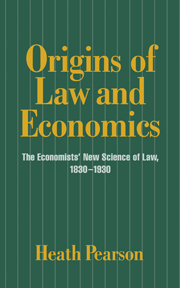2 - Toward a normal science
Published online by Cambridge University Press: 12 January 2010
Summary
Two impulses jostled for primacy in the new science. On the one hand, there was an appealing parsimony and rigor (and even cynicism) in the ideal of assimilating the theory of legal evolution to the same model of human behavior – that is, rational hedonism – that dominated economic theory as a whole. On the other hand, economists had not yet reached the point of specialization where they would decline, on methodological principle, to consider any behavioral models that diverged from rational hedonism. The first of these impulses will be explored in this chapter, the second one in chapter 3.
In the present chapter our agenda will be to revise an entrenched notion in the historiography of economic thought: namely, that early institutional economics (including that which we have termed the “new science”) would have no truck with such reductionist constructs as homo oeconomicus and the materialist conception of history. This notion has suffused discussion in the field. Indeed, the conventional distinction between the pre-Coasian and the more recent “neoclassical” vintages of institutionalism derives, at base, from the idea that only the latter version has – for better or worse – embraced the axiom of instrumental rationalism, and has fitted its stories about institutional selection to it. We will argue against this interpretation. In actuality, much of the new science did proceed from a unified, rationalegoistic theory of economic behavior, one which would cover not only the production, exchange, and consumption of goods but the transaction of rules as well. In this respect, practitioners of the new science were seeking to make of it a “normal” science.
- Type
- Chapter
- Information
- Origins of Law and EconomicsThe Economists' New Science of Law, 1830–1930, pp. 43 - 70Publisher: Cambridge University PressPrint publication year: 1997

